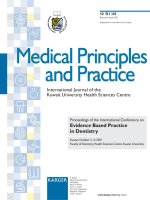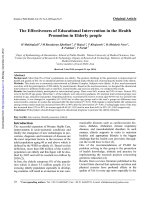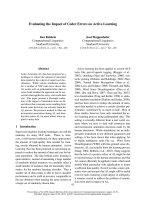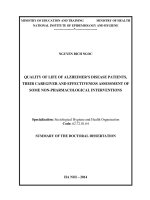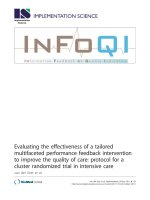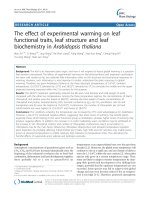Evaluating the effectiveness of educational intervention on evidence based practice knowledge, attitudes and beliefs among vietnamese’ nurses
Bạn đang xem bản rút gọn của tài liệu. Xem và tải ngay bản đầy đủ của tài liệu tại đây (3.19 MB, 90 trang )
Evaluating the Effectiveness of Educational Intervention on
Evidence-based Practice Knowledge, Attitudes and Beliefs among
Vietnamese’ Nurses
By
Nguyen Van Giang
Submitted for the degree of
Doctor of Philosophy
Dissertation Advisor: Dr. Shu Yuan Lin
School of Nursing
Kaohsiung Medical University
January 2021
Evaluating the Effectiveness of Educational Intervention on
Evidence-based Practice Knowledge, Attitudes and Beliefs among
Vietnamese’ Nurses
By
Nguyen Van Giang
Submitted for the degree of
Doctor of Philosophy
Dissertation Advisor: Dr. Shu Yuan Lin
School of Nursing
Kaohsiung Medical University
January 2021
I
ABSTRACT
Background: Evidence-based practice (EBP) has become an important element in delivering
optimal quality of care. Barriers to the EBP implementation by nursing professionals include a
lack of knowledge, less positive attitude and beliefs on EBP. However, few studies have been
conducted to evaluate the effectiveness of educational interventions to improve their knowledge,
attitudes and beliefs on EBP.
Objectives: To evaluate the effectiveness of multiple educational strategies on EBP knowledge,
attitude and beliefs among Vietnamese nurses.
Methods: This study was an experimental study with an experimental group and a comparison
group using a pretest-posttest design. Participants included head nurses, nurses and midwives
who were enrolled from August to September 2020 at the national hospital in Vietnam. A total of
148 participants (76 in the comparison group and 72 in the experimental group) received four
weeks of educational interventions. The experimental group received multiple educational
strategies of EBP including face-to-face lectures, mentoring and online learning. The comparison
group received Incentive spirometry educational intervention on the same date and same period
of intervention. The effectiveness of educational interventions was evaluated at pretest and
posttest using the Vietnamese version of the EBP Knowledge test, EBP Attitude scale and EBP
Beliefs scale. The statistical software IBM SPSS 20 was used to analyze the data.
Results: A total of 136 participants (66 in the comparison group and 70 in the experimental
group) completed four weeks of educational interventions. The attrition rate was 8%. The mean
age of participants was 36.76 years and more than 77 % of them were females. Participants who
had never participated in any EBP training course account for 72.2 %. There were significant
differences between the experimental group and the comparison group in participants’ EBP
knowledge, attitude and beliefs at posttest. Participants’ EBP knowledge, attitudes and beliefs in
the experimental group were significantly improved at posttest compared to pretest.
II
Conclusions: Multiple educational strategies of EBP interventions were effectively improved
nurses’ EBP knowledge, attitude and beliefs. The findings can be used as an important reference
for improving EBP knowledge, attitude and beliefs on nursing students and other healthcare
professionals.
KEYWORDS: evidence-based practice, nurses, education, mentoring, knowledge, attitude.
III
ACKNOWLEDGMENTS
I iwould ilike ito iacknowledge iseveral ipeople iwho ihave isupported ime iduring imy
i
doctoral ijourney. iFirst, iI iwould ilike ito iexpress imy ispecial ithank ito imy iadvisor iDr. iShu-Yuan
i
Lin. iI iam igrateful ifor iher iexpertise, iwisdom iand ifriendship iwhich ihave iserved ito ikeep ime
i
focused, igrounded and guided the project from the beginning to the end. iWithout iher isupport
i
and iguidance, iI icould inot ihave icompleted ithis idissertation. I also would like to thank the other
staff and professors at College of Nursing, Kaohsiung Medical University who provided
some forms of support.
Second, iI iwould ilike ito iextend imy igratitude ito iDr. iStevens ifor iallowing ime ito iuse ithe
i
Evidence-based iPractice iKnowledge itest, iDr. iAarons ifor iusing ithe iEvidence-based iPractice
i
Attitude iand ito iDr. iBernadette iMelnyk iand iDr. iEllen iFineout-Overholt ifor ipermitting ime ito
i
use ithe iEvidence-based iPractice iBeliefs in this study.
Third, iI iwould ilike ito iexpress imy igratitude ito ithe iVice ipresident iof iThai iNguyen
i
National iHospital, iVietnam, iDr. iDuong iHong iThai, iwho isupported iand iapproved imy idata
i
collection. iHis iconnections iwith iall iclinical iunits ihelp ime ito iconduct ithe ieducational
interventions iwithout icosting ime itoo imuch. iThat isaved ime ia ilot iof imoney iin icompleting ithis
i
study.
Last ibut inot ileast, iI iwould ilike ito ithank iteachers, imentors iand iall iparticipants in this
study. iThanks iyou ifor iyour itime iand ihonest iresponses iinvolved iin ithis istudy. i
IV
TABLE OF CONTENTS
ABSTRACT ......................................................................................................................... II
ACKNOWLEDGMENTS................................................................................................. III
TABLE OF CONTENTS .................................................................................................... V
LIST OF ABBREVIATIONS ........................................................................................ VIII
LIST OF TABLES..............................................................................................................IX
LIST OF FIGURES............................................................................................................. X
LIST OF APPENDICES ....................................................................................................XI
CHAPTER ONE ................................................................................................................... 1
Introduction .......................................................................................................................... 1
Background of the Study ........................................................................................................ 1
Purposes of the Study ............................................................................................................. 4
Research Questions ................................................................................................................ 5
Research Hypotheses .............................................................................................................. 6
Definitions of Variables ......................................................................................................... 7
CHAPTER TWO .................................................................................................................. 9
LITERATURE REVIEW .................................................................................................... 9
Evidence-based Practice ........................................................................................................ 9
Developing history ........................................................................................................... 9
Definition of evidence-based practice .............................................................................. 9
Benefits of evidence-based practice ............................................................................... 10
Barriers of evidence-based practice ............................................................................... 10
Conceptual models of EBP............................................................................................. 11
Nurses’ Knowledge of Evidence-based Practice ................................................................... 13
Nurses’ Attitude toward Evidence-based Practice ................................................................. 14
V
Nurses’ Beliefs about Evidence-based Practice ..................................................................... 16
Reviews the effectiveness of EBP educational intervention.................................................. 18
Procedures ...................................................................................................................... 18
Data extraction and synthesis ......................................................................................... 19
Main findings ................................................................................................................. 21
Conclusions .................................................................................................................... 22
CHAPTER THREE ........................................................................................................... 23
Methodology........................................................................................................................ 23
Study Design .................................................................................................................. 24
Setting ............................................................................................................................. 24
Sampling ......................................................................................................................... 24
Cluster randomized design ............................................................................................. 25
EBP Educational Intervention ........................................................................................ 25
Incentive Spirometry Educational Intervention ............................................................. 26
Instruments ..................................................................................................................... 30
Demographic and work characteristics sheet ............................................................. 30
The V-ACE-ERI knowledge test ............................................................................... 30
The V-EBPA .............................................................................................................. 31
The V-EBPB .............................................................................................................. 31
Procedures ...................................................................................................................... 32
Data Analysis ................................................................................................................. 35
Ethical Consideration ..................................................................................................... 36
CHAPTER FOUR .............................................................................................................. 37
Results.................................................................................................................................. 37
Demographic and Work Characteristics of Participants ................................................ 37
VI
Comparisons of EBP Knowledge between Two Groups ............................................... 39
Comparisons of EBP Knowledge within Two Groups .................................................. 39
Comparisons of the Correct Percentage of Knowledge Items between Pretest and
Posttest............................................................................................................................ 40
Comparisons of EBP Attitudes between Two Groups ................................................... 42
Comparisons of EBP Attitudes within Two Groups ...................................................... 42
Comparisons of the Percent of Positive Attitude Items between Pretest and Posttest ... 43
Comparisons of EBP Beliefs between Two Groups ...................................................... 45
Comparisons of EBP Beliefs within Two Groups.......................................................... 45
Comparisons of the Percent of Positive Beliefs Items between Pretest and Posttest ..... 46
CHAPTER FIVE ................................................................................................................ 48
Discussion ............................................................................................................................ 48
Demographic and Work Characteristic of Participants .................................................. 48
Comparisons in Changes of EBP Knowledge between Group and Time ...................... 49
The Correct Percentage of Knowledge Items between Pretest and Postest ................... 50
Comparisons in Changes of EBP Attitude between Group and Time ........................... 51
The Percent of Positive Beliefs Items between Pretest and Posttest .............................. 52
Comparisons in Changes of EBP Beliefs between Group and Time ............................. 22
The Percent of Positive Beliefs Items between Pretest and Posttest .............................. 54
Effectiveness of Educational Intervention in EBP ......................................................... 54
Strengths of the Study .................................................................................................... 56
Limitations of the Study ................................................................................................. 57
Implications of the Study ............................................................................................... 58
CONCLUSION .................................................................................................................... 60
REFERENCES ..................................................................................................................... 61
VII
LIST OF ABBREVIATIONS
ACE-ERI
Academic Center for Evidence-based Practice Readiness Inventory
CFA
Confirmatory Factor Analysis
EBP
Evidence-based Practice
EBP-A
Evidence-based Practice Attitude
EBP-B
Evidence-based Practice Beliefs
EBPQ
Evidence-based Practice Questionnaires
EFA
Exploratory Factor Analysis
PCA
Principal Component Analysis
PICO
Population, Intervention, Comparision and Outcomes
V-ACE-ERI
Vietnamese version of the ACE-ERI
V-EBPA
Vietnamese version of Evidence-based Practice Attitude
V-EBPB
Vietnamese version of Evidence-based Practice Beliefs
VIII
LIST OF TABLES
Table 1
The EBP educational intervention
28
Table 2
Incentive spirometry educational intervention
29
Table 3
Demographic and work characteristics of Participants
38
Table 4
Comparisons of EBP knowledge scores between two groups
39
Table 5
Comparisons of EBP knowledge scores within two groups
39
Table 6
Comparisons of the correct percentage of knowledge items
between pretest and posttest
41
Table 7
Comparisons of EBP attitude scores between two groups
42
Table 8
Comparisons of EBP attitude scores between two groups
42
Table 9
Comparisons of the percent of positive attitude items between
pretest and posttest
44
Table 10
Comparisons of EBP beliefs scores between two groups
45
Table 11
Comparisons of EBP beliefs scores between two groups
45
Table 12
Comparisons of the percent of positive beliefs items between
pretest and posttest
47
IX
LIST OF FIGURES
Figure 1
The Stevens Star Model of Knowledge Transformation©
12
Figure 2
The PRISMA Diagram
20
Figure 3
Study Framework
23
Figure 4
Recruitment and Procedures of Data Collection
34
X
LIST OF APPENDICES
Appendix A
Demographic and work characteristics sheet
71
Appendix B
The Vietnamese ACE-ERI knowledge test
73
Appendix C
The Vietnamese evidence-based practice attitude scale
75
Appendix D
The Vietnamese evidence-based practice beliefs scale
76
Appendix E
Permission to use the ACE ERI tool
77
Appendix F
Permission to use the EBP - A scale
78
Appendix G
Permission to use the EBP - B scale
79
Appendix H
Informed consent
80
Appendix I
Institutional Review Broad Approval
82
Appendix K
Schedules for EBP educational intervention
83
Appendix L
Description of the study in the review
85
Appendix M Synthesis of the category describing contents, teaching and
learning method and outcome of educational intervention
XI
98
CHAPTER ONE
Introduction
This chapter comprised the background of the study, purposes of the study, research
questions, research hypotheses, and definitions of variables.
Background of the Study
Globally, evidence-based practice (EBP) has been acknowledged in the nursing
profession over the past three decades. Evidence-based practice is an approach to narrowing
the gap between research and practice (Green, 2014; Worum, Lillekroken, Ahlsen, Roaldsen
& Bergland, 2019), which incorporates the best research evidence with healthcare
professional’s clinical expertise and patient’s preference (Disler, White, Franklin, Armari &
Jackson, 2019; Melnyk, Gallagher-Ford, Long & Fineout-Overholt, 2014; Straus, Glasziou,
Richardson & Haynes, 2018). The Institute of Medicine suggested that 90% of clinical
decisions made should base on evidence by 2020 (Institutes of Medicine, 2011).
The evidence-based practice provides nurses a problem-solving approach to assist in
developing professional nursing roles, deliver high quality of care, improve patient outcomes
and decrease healthcare costs (Khammarnia, Haj, Amani, Rezaeian & Setoodehzadeh, 2015;
Melnyk et al., 2014; Stevens, 2013). To date, the progress of implementing EBP in the
nursing profession is slow because nurses face numerous barriers (Alatawi et al., 2020;
Khammarnia et al., 2015; Malik, McKenna & Plummer, 2016). These barriers include lack of
continuous education in academic and practice setting, insufficient EBP knowledge, lack of
time, negative attitude toward EBP, negative belief about EBP, lack of searching skills, lack
of mentors’ support, insufficient English proficiency and inadequate databases (Baird &
Miller, 2015; Duncombe, 2018; Jun, Kovner & Stimpfel, 2016).
The EBP knowledge, attitude and beliefs among nurses are very important elements
in implementing EBP (AbuRuz, Hayeah, Dweik & Akash, 2017; Jun et al., 2016; Kang &
1
Yang, 2016). According to Yoo and colleagues (2019), improving the knowledge, attitude
and beliefs among nurses is the first step of EBP implementation. Nurses’ knowledge,
attitude and skills of EBB allow their abilities to implement EBP (Bianchi et al., 2018;
Khammarnia et al., 2015; Majid et al., 2011). Nurses with positive attitudes and beliefs of
EBP would improve their abilities and confidence to implement EBP (Kang & Yang, 2016;
Melnyk, Fineout-Overholt, Giggleman & Cruz, 2010).
The EBP educational intervention has been demonstrated to improve nurses’ skills,
knowledge of EBP, positive attitudes toward EBP and positive behaviors in implementing
EBP (Hassona & Winkelman, 2014; Koota, Kääriäinen & Melender, 2018; Melender, Mattila
& Haggman-Laitila, 2015). The EBP educational intervention plays an important role in
assisting nurses to acquire knowledge and skills of EBP (Häggman-Laitila, Mattila, &
Melender, 2016; Keele, 2010). Thus, an effective EBP educational intervention could provide
nurses with sufficient knowledge and skills to implement EBP in practice and evaluate the
outcomes (Cruz et al., 2016; Verloo, Desmedt & Morin, 2017; Zhou, Hao, Guo & Liu, 2016).
Likewise, Wallin and colleagues (2003) indicated nurses who received effective EBP
educational interventions were more likely to implement EBP projects in practice. However,
effective EBP interventional education has not been identified in the clinical settings (Black,
Balneaves, Garossino, Puyat & Qian, 2015; Stokke, Olsen, Espehaug & Nortvedt, 2014).
There is limited study examing the effect of EBP educational intervention on nurses’
knowledge, attitude and beliefs of EBP implementation in developing countries (Saunders &
Vehviläinen-Julkunen, 2016). The previous studies reported significant barriers in
implementing EBP in developing countries such as insufficient EBP knowledge, inadequate
EBP skills, negative attitude and beliefs of EBP and insufficient administrative supports
(Chang, Russell & Jones, 2010; Chen, Shao, Hsiao & Lee, 2013; Wang, Jiang, Wang & Bai,
2013). A study conducted in Taiwan found 25.5 % of nurses had sufficient knowledge and
2
only 12.3% of them had adequate skills to implement EBP (Weng et al., 2015). A Vietnam
study found 60% of healthcare professionals had the basic knowledge of EBP in primary care
(Eriksson et al., 2009). Another study conducted in Vietnam showed only 29.5% of
Vietnamese nurses familiar with the EBP terminology and 22.7% of them felt confident about
EBP skills. Only 57.7% of nurses believed in EBP implementation enhancing the quality of
care (Nguyen & Wilson, 2016). A recent Vietnam study found 73.4% of nurses had never
received EBP training and 44.4 % of them had never heard about the terminology “EBP”
(Giang, Lin & Thai 2020). Therefore, there was an urgent need for implementing EBP
educational intervention to promote nurses’ knowledge, attitude and beliefs of EBP in
Vietnam (Nguyen & Wilson, 2016; Wiechula, Nguyen & Rasmussen, 2014). The purpose of
this study was to evaluate the effectiveness of an educational intervention on evidence-based
practice knowledge, attitudes and beliefs among Vietnamese nurses.
3
Purposes of the Study
The specific purposes of this study are listed as follows:
1. To evaluate the effectiveness of educational intervention on evidence-based practice
knowledge among nurses.
2. To evaluate the effectiveness of educational intervention on evidence-based practice
attitudes among nurses.
3. To evaluate the effectiveness of educational intervention on evidence-based practice
beliefs among nurses.
4
Research Questions
Research questions were listed as follows:
Research question 1. What were the differences between the experimental and comparison
groups in nurses’EBP knowledge at the posttest?
Research question 2. What were the changes between pretest and posttest in nurses’EBP
knowledge in the experimental group?
Research question 3. What were the differences between the experimental and comparison
groups in nurses’EBP attitudes at the posttest?
Research question 4. What were the changes between pretest and posttest in nurses’EBP
attitudes in the experimental group?
Research question 5. What were the differences between the experimental and comparison
groups in nurses’EBP beliefs at the posttest?
Research question 6. What were the changes between pretest and posttest in nurses’EBP
beliefs in the experimental group?
5
Research Hypotheses
Research hypotheses were assumed as follows:
Hypothesis 1. There were significant differences between the experimental and comparison
groups in nurses’EBP knowledge at the posttest.
Hypothesis 2. There were significant differences between pretest and posttest in nurses’EBP
knowledge in the experimental group.
Hypothesis 3. There were significant differences between the experimental and comparison
groups in nurses’EBP attitudes at the posttest.
Hypothesis 4. There were significant differences between pretest and posttest in nurses’EBP
attitudes in the experimental group.
Hypothesis 5. There were significant differences between the experimental and comparison
group in nurses’EBP beliefs scores at the posttest.
Hypothesis 6. There were significant differences between pretest and posttest in nurses’EBP
beliefs in the experimental group.
6
Definitions of the Variables
Conceptual and operational definitions of the variables were presented as follows:
Knowledge of evidence-based practice
1. Conceptual definition
It also refers to nurses’ understanding of EBP steps, study designs, levels of evidence,
and clinical practice guidelines (Stevens, 2004)
2. Operational definition
It was measured by the 15-item multiple-choice questions of the EBP knowledge test, a
part of the ACE EBP readiness inventory (ACE-ERI) (Stevens, Puga & Low, 2012; Stevens,
2004). A higher score means more knowledge of EBP.
Attitude toward evidence-based practice
1. Conceptual definition
It refers to a nurses’ intention to adopt innovative types of therapy, interventions, or
treatments in practice (Aarons, 2004).
2. Operational definition
It was measured by the Vietnamese version of the evidence-based practice attitude
scale (Giang et al., 2020). The scale contained 14 items including four dimensions of openness,
requirements, appeal, and divergence. A higher score means more positive attitudes toward
EBP implementation.
Beliefs about evidence-based practice
1. Conceptual definition
It refers to nurses’ perceptions, values, confidence and abilities to implement EBP
(Melnyk, Fineout-Overholt & Mays, 2008).
2. Operational definition
7
It was measured by the Vietnamese version of the evidence-based practice belief scale
(Giang et al., 2020). This scale contained 16 items including four dimensions of value beliefs,
knowledge beliefs, resource beliefs, and time and difficulty beliefs. A higher score means more
positive beliefs about EBP implementation.
Educational intervention on evidence-based practice
It refers to EBP teaching and learning methods that may be done by a single strategy
or multiple strategies such as face-to-face lectures, workshops, discussion, mentoring,
conferences and online learning sessions (Dawes et al., 2005; Tilson et al., 2011). The EBP
curriculum needs to be grounded on the five steps of EBP (Ask, Acquire, Appraise, Apply
and Assess). Learning goals should include four components as follows: knowledge/skills,
attitude, beliefs and practice (Dawes et al., 2005; Melnyk et al., 2014).
Face-to-face lecture is a teacher-centered method of education where course content
and learning material are taught in person to a group of learner. This allows learners benefit
from a greater level of interaction between learners and an teacher (Davis et al., 2007).
Mentoring is a relationship between a more experienced person, the mentor, and a less
experienced person, the mentee or trainee, within which important career skills are
transferred from one to the other (Roe & Whyte-Marshall, 2012).
Online learning is defined as learning that takes place partially or entirely over the
Internet (Means et al., 2010)
8
